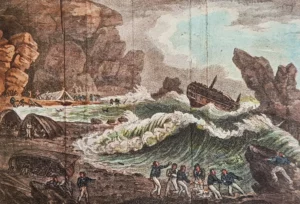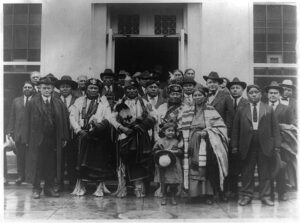What a fun vocation to pluck from the annals of history the most remarkable stories and make them come to life. I fear envy has crept into my heart. David Grann, you have the career that I can only dream of, but I’m glad for your hard work because I and countless others have been enriched, challenged, and sobered by these remarkable tales that come from your pen.
The Wager — It’s the 1740s”s Britain has made its move to surpass Spain as the world’s most dominant empire. Seven ships are commissioned to sail around the world, causing havoc for any Spanish ships they can find. The trip is an unmitigated disaster. Poorly planned and inadequately staffed, the 2000 sailors and marines don’t get far before they are smashed with a typhus outbreak as they cross the Atlantic and head south along the coast of South America. Scurvey then decimates another large chunk of the already dwindling population. Next, they attempt to cross Cape Horn, the deadliest sea on the planet, at precisely the worst time of year. Five of the ships make it, but the Wager crashes on a deserted island on the Pacific Ocean side. The tale becomes one of starvation, mutiny, and murder as the beleaguered seamen try to survive. Eventually, a contingent of men use what remains of the lifeboats to make the 3000-mile journey back to Brazil and by and by back home to England. The Captain is left behind with a few men to die on the Island as punishment for murder and bad leadership. But they cheat death, and with the help of some indigenous people, they make a 300-mile journey North to a Spanish outpost, where they are captured and thrown in prison.
Britain has made its move to surpass Spain as the world’s most dominant empire. Seven ships are commissioned to sail around the world, causing havoc for any Spanish ships they can find. The trip is an unmitigated disaster. Poorly planned and inadequately staffed, the 2000 sailors and marines don’t get far before they are smashed with a typhus outbreak as they cross the Atlantic and head south along the coast of South America. Scurvey then decimates another large chunk of the already dwindling population. Next, they attempt to cross Cape Horn, the deadliest sea on the planet, at precisely the worst time of year. Five of the ships make it, but the Wager crashes on a deserted island on the Pacific Ocean side. The tale becomes one of starvation, mutiny, and murder as the beleaguered seamen try to survive. Eventually, a contingent of men use what remains of the lifeboats to make the 3000-mile journey back to Brazil and by and by back home to England. The Captain is left behind with a few men to die on the Island as punishment for murder and bad leadership. But they cheat death, and with the help of some indigenous people, they make a 300-mile journey North to a Spanish outpost, where they are captured and thrown in prison.
Meanwhile, the group of 70 or so that is picking their way North along the East coast of South America is dying off at a prodigious pace. Four of the strongest jump overboard and swim to shore in a desperate bid to hunt seals and stave off starvation. The boat, under mysterious circumstances, goes on without them, leaving them to die. Eventually, about 30 make it back to England, and they are hailed as heroes. The ring leader of the survivors writes a memoir about the events, taking careful measures to justify his actions against his captain. Time goes by, but then the Captian shows up in England and he has quite a different story to tell. A trial takes place. The entire world of the 1740’s, it seems, follows the courtroom drama with great interest. Finally, the British Admiralty, to everyone’s surprise, declares no one guilty. Years go by, and then, surprisingly, two of the four seamen who had been abandoned while hunting seals show up in England, and they have a different story to tell as well. David pieces this story together masterfully using the mountains of material left behind from personal journals, news articles, court reports and the several memoirs that were written about the voyage.
Killers of the Floor Moon – For a time in the 1920’s, the Osage Indian tribe were the wealthiest people in America. They had been kicked off their land and unceremoniously bounced around from place to place until they landed on a rocky chunk of ground in Oklahoma that no one wanted. Unknown to everyone, just under that little bit of earth lay entire lakes of oil. An “Indian-loving” lawyer managed to secure the right of not only the land for the Osage but also everything under the land. Overnight, this tribe became wealthy beyond their wildest dreams. Sadly, this is no rags-to-riches feel-good story. The government and opportunistic whites at all levels of society found shockingly creative ways to fleece the Indians of their money. The justifying attitude was that these were “just dumb Indians,” so it didn’t really matter. Straight-up murder became common, mostly by poisoning. But the most revolting of plans to claim the head rights of the Osage came from Bill Hale. He endeared himself to the tribe, convincing them of his devotion. He even arranged for his nephews to marry into the tribe, and then slowly but surely, with his nephews as his underlings, he killed off the “In-laws” one by one. Hale enacted a reign of terror in which 24 Osage were shot, blown up, and poisoned. It was the fledgling FBI that managed to crack the case and bring Bill and his nephews to justice, but the task proved almost impossible because of the widespread corruption that “the Indian business” had created for so many in the South. As Dave did his research, he uncovered dozens and dozens of suspicious deaths that were never investigated. This story is yet another tragedy against indigenous people.
For a time in the 1920’s, the Osage Indian tribe were the wealthiest people in America. They had been kicked off their land and unceremoniously bounced around from place to place until they landed on a rocky chunk of ground in Oklahoma that no one wanted. Unknown to everyone, just under that little bit of earth lay entire lakes of oil. An “Indian-loving” lawyer managed to secure the right of not only the land for the Osage but also everything under the land. Overnight, this tribe became wealthy beyond their wildest dreams. Sadly, this is no rags-to-riches feel-good story. The government and opportunistic whites at all levels of society found shockingly creative ways to fleece the Indians of their money. The justifying attitude was that these were “just dumb Indians,” so it didn’t really matter. Straight-up murder became common, mostly by poisoning. But the most revolting of plans to claim the head rights of the Osage came from Bill Hale. He endeared himself to the tribe, convincing them of his devotion. He even arranged for his nephews to marry into the tribe, and then slowly but surely, with his nephews as his underlings, he killed off the “In-laws” one by one. Hale enacted a reign of terror in which 24 Osage were shot, blown up, and poisoned. It was the fledgling FBI that managed to crack the case and bring Bill and his nephews to justice, but the task proved almost impossible because of the widespread corruption that “the Indian business” had created for so many in the South. As Dave did his research, he uncovered dozens and dozens of suspicious deaths that were never investigated. This story is yet another tragedy against indigenous people.
Interesting Observations:
Mindbending Wickedness of the Guardianship Plan — Because of “racial weakness“ the Supreme Court ruled that based on the quantum of Indian blood in a person, they would need to have a court-appointed guardian that would oversee their money. The court viewed the Osage as mentally equivalent to 6-8 year olds. The abuse this program fomented can’t even be quantified.
Americans Anti-Police Anti-Big Government: Even up until the 1930’s many parts of America still refused the idea of government-run police forces. I am still coming to see how innate a hatred and suspicion Americans have of government. In true Jeffersonian fashion, the American people wanted to rule and police themselves at a local level. Whatever abuses this would create wouldn’t be worse than what kings and dictators could do with standing armies and massive law enforcement agencies. Eventually, that thinking had to change, and the Osage tragedy was a key part of the United States’ transformation into big police and big government.
Kawesqar people — These were Indigenous people near Cape Horn who kept warm by rubbing seal blubber over their skin instead of wearing lots of clothes. In the near-freezing water, their women would dive up to 30 feet and stay underwater “for so long a time that it would be impossible to believe by persons who have not been eye-witnesses,” wrote John Bulkeley in his journal.
The especially sad story of John Duck — John was a free black sailor who made the trip with the mutineers but was ditched with three others while hunting seals. They managed to survive by walking hundreds of miles through the jungle, but sadly, when they arrived in Brazil, he proved to have the wrong skin colour. The ordeal of sickness, shipwreck, mutiny, starvation, icy storms, and jungle survival was over for his mates, but John Duck’s problems were just beginning. He was captured and sold to a sugar plantation, where he was almost certainly worked to death.




